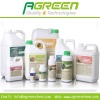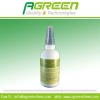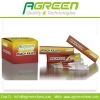
1)Phoxim 50%EC 2)Quality Certificate by SGS 3)Fine packet or as per requirement 4)Competitive price.
PYMETROZINE
Biochemistry: Cholinesterase inhibitor.
Mode of action: Non-systemic insecticide with contact and stomach action. Short duration of activity.
Uses: Control of stored-product insects in granaries, mills, silos, ships, etc.; ants and other insects in households and in public health; caterpillars (mainly Spodoptera spp.) and soil insects in maize, vegetables, potatoes, beet and cereals, at 5 kg/ha; also migratory locusts. Phytotoxicity May exhibit some phytotoxicity to cotton.
Formulation types: DP; EC; GR; KN; UL; WP; Seed treatment.
Compatibility: Incompatible with alkaline materials.
Mammalian toxicology:Oral Acute oral LD50 for rats 5820 mg/kg. Skin and eye Acute percutaneous LD50 for rats >2000 mg/kg. Non-irritating to the skin and eyes (rabbits). Not a skin sensitiser to guinea pigs. Inhalation LC50 (4 h) >1800 mg/m3 air. NOEL (2 y) for rats 3.7 mg/kg b.w. daily. ADI 0.03 mg/kg b.w. Other Non-mutagenic in 5 assay tests including the Ames test. Toxicity class WHO (a.i.) III
Ecotoxicology:Birds Acute oral LD50 for bobwhite quail, mallard ducks >2000 mg/kg. LC50 (8 d) for bobwhite quail >5200 ppm. Fish LC50 (96 h) for rainbow trout and common carp >100 mg/l. Daphnia LC50 (48 h) 87 mg/l. Algae LC50 (72 h) for Scenedesmus subspicatus 47.1 mg/l; LC50 (5 d) for Selenastrum capricornutum 21.7 mg/l. Bees LD50 (48 h) (oral) >117 mg/bee; (contact) >200 mg/bee. Worms LC50 (14 d) for Eisenia foetida 1098 mg/kg soil. Other beneficial spp. Harmless to Aleochara bilineata, Poecilus cupreus, Typhlodromus pyri, Orius insidiosus, Aphidius colemani, Aphidius matricariae, Chrysoperla carnea.
Environmental fate:Animals Quickly and efficiently eliminated (mainly via excreta) and extensively metabolised in all species tested (rats, farm animals), without accumulation in most major animal food products. The metabolic pathways are similar for all species. Pymetrozine is the relevant residue for assessing the consumer exposure to treated animal food products. Plants The basic degradation steps are similar in all investigated crops; pymetrozine is the only relevant compound for residue definition. Soil/Environment In soils, very rapidly and strongly adsorbed, with low mobility and low leaching potential. Soil DT50 2-69 d, DT90 55-288 d. Rapidly degraded in slightly acidic or sunlight-exposed surface water; DT50 in surface water (typical value) 7 d. Slightly volatile. Efficiently removed by direct photolysis and photochemically induced oxidation.
Phoxim50%EC











